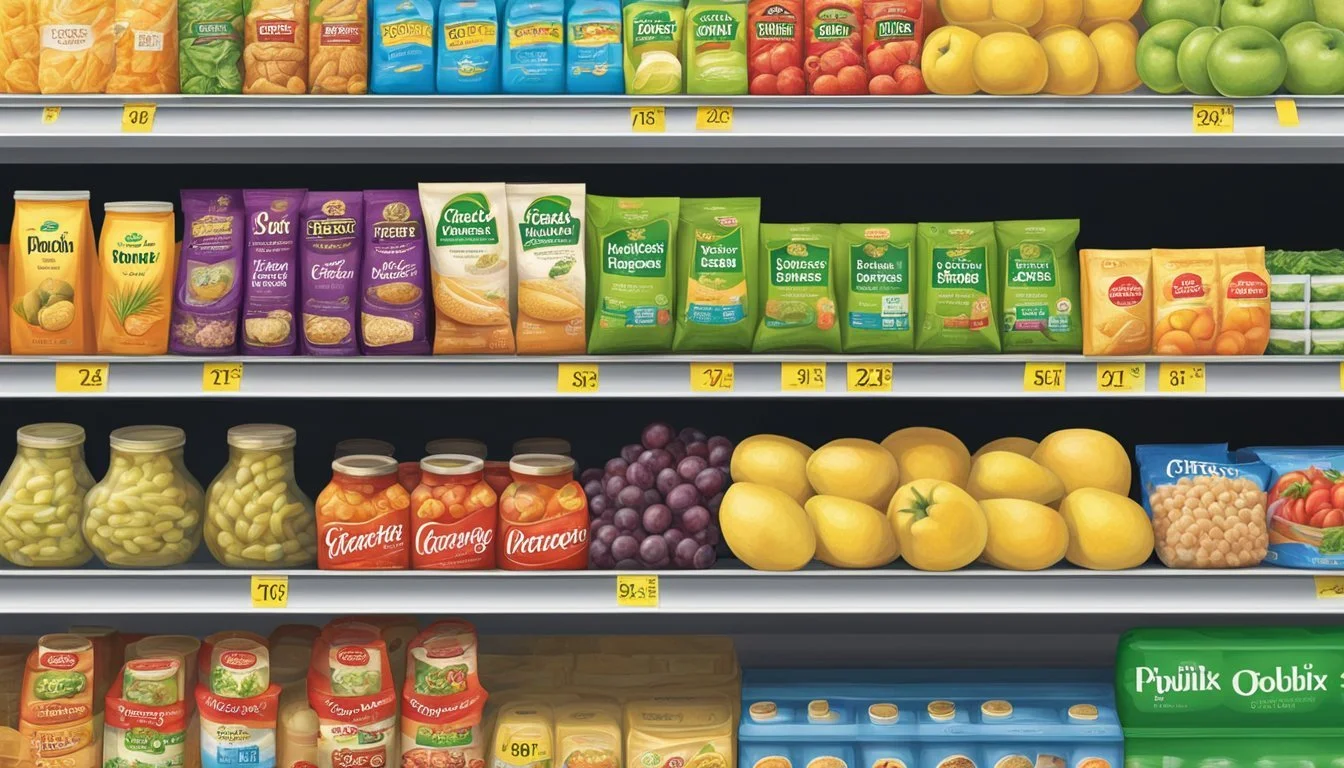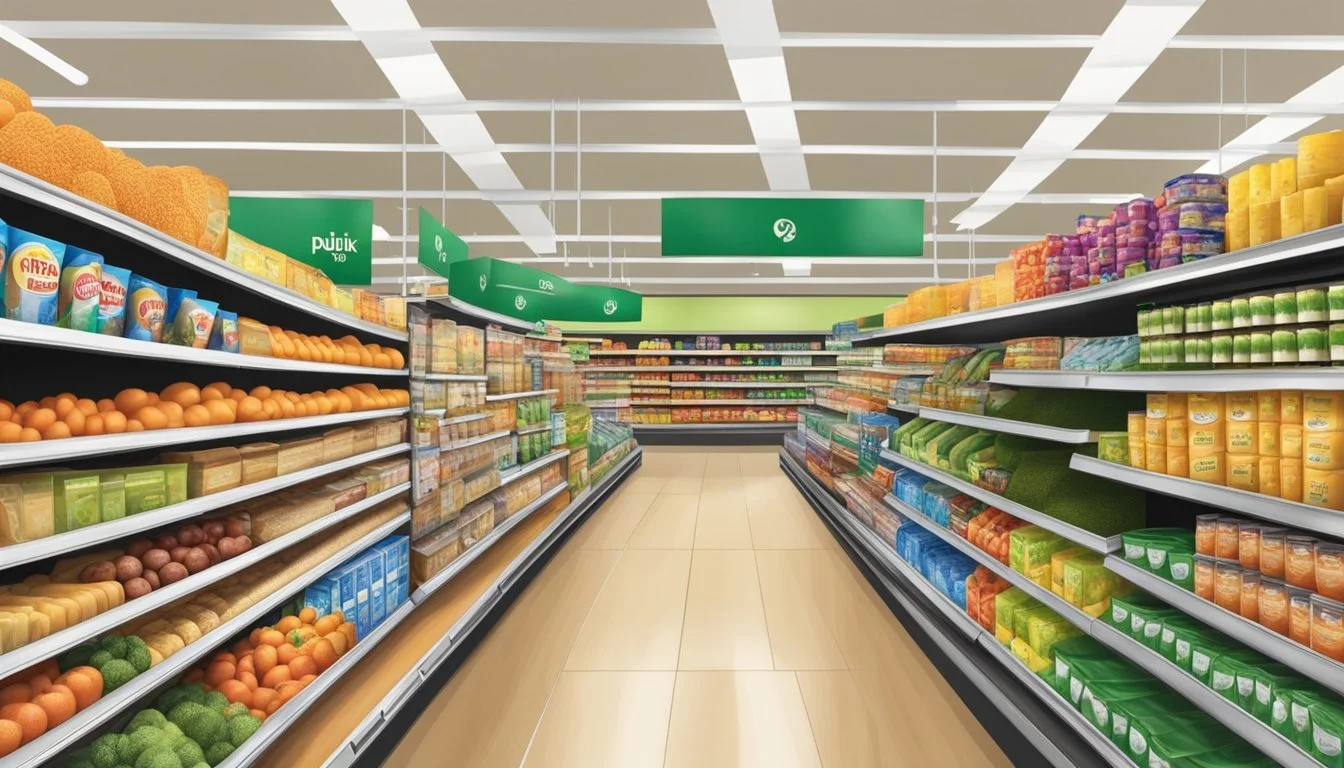Is Publix Cheaper Than ShopRite?
Comparing Grocery Prices
Part of Our Grocery Store Guide with Details on Publix Prices and ShopRite Prices
Determining whether Publix is cheaper than ShopRite involves a multifaceted approach, considering various factors that affect grocery pricing. Both Publix and ShopRite have established a significant presence on the East Coast with Publix widely recognized in the southeastern states and ShopRite predominantly operating in the Northeast. These grocery chains cater to different regional preferences, which is a contributing factor in their pricing strategies.
In a price comparison, several variables come into play including store location, product brands, and current discounts or promotions. Publix, known for its clean stores and customer service, may offer a shopping experience that justifies a slightly higher price point on some items. ShopRite, on the other hand, often promotes a value-centric approach with weekly discounts and incentives for its customers. Thus, while the overall perception might suggest Publix as the more upscale option, ShopRite's aggressive pricing could make it the more economical choice for budget-conscious shoppers.
When comparing prices on staple grocery items, it is not uncommon to find that certain products may be less expensive at Publix or vice versa at ShopRite. Brand loyalty programs, store brand quality, and seasonal deals could sway consumers towards one or the other. Additionally, both Publix and ShopRite offer unique benefits and drawbacks that extend beyond the price tag, making the decision of "which is cheaper" dependent on the individual shopping list and personal priorities of the customer.
Comparing Grocery Pricing Strategies
When comparing Publix to ShopRite, it is essential to understand their differing grocery pricing strategies. Both aim to provide consumers with value, yet their approaches may vary.
Publix is known for a customer-centric shopping experience. They tend to offer:
National Brands: A strong emphasis on well-known brands.
Deals: Weekly specials and BOGO (Buy One Get One) deals are common.
Coupons: They provide a plethora of store and manufacturer coupons.
In contrast, ShopRite operates as a discount supermarket chain with a focus on savings through:
Generic Brands: An extensive variety of store brands and generic options.
Low Prices: Generally lower shelf prices on a range of items.
Discount Programs: Their Price Plus Club offers additional savings.
Strategy Publix ShopRite Brand Focus National brands Generics and Store brands Price Approach Regular deals and coupons Consistent low prices Loyalty Programs Publix Club; Opportunities for savings Price Plus Club; Exclusive discounts
Consumers may find that Publix, while offering regular discounts, may have higher base prices compared to ShopRite. In contrast, ShopRite often promotes lower everyday prices, providing immediate savings without requiring additional deals or coupons. Understanding these strategies allows customers to tailor their shopping habits to maximize their savings based on their brand preferences and willingness to engage in deal hunting.
Store Location and Regional Variability
When comparing Publix and ShopRite in terms of pricing, it's essential to understand the geographical footprint of each supermarket. Both grocery chains are predominant on the East Coast of the United States, but they have distinct regional strongholds.
Publix primarily operates in the Southeastern region. Its stores are concentrated in states like Florida, Georgia, Alabama, and the Carolinas. They've been expanding their presence throughout the Southeast, opening new locations and remodeling existing ones to enhance the shopping experience for customers.
ShopRite, on the other hand, has its roots deeply embedded in the Northeast. This grocery chain is a familiar sight in states such as New Jersey, New York, and Pennsylvania. Their stronghold in the Northeast positions them as a go-to supermarket option for many shoppers in these states.
Given this regional variability, a shopper's location significantly influences whether Publix or ShopRite is more accessible and, by extension, whether one might offer better pricing than the other. Pricing strategies may also vary between locations based on the local cost of living, the competitive landscape, and the demographics of the region.
A comparison within the New York area, where ShopRite is more prevalent, might yield different results than a comparison in Southeastern locations where Publix dominates.
Here's a snapshot of their regional presence:
Supermarket Primary Region Publix Southeast ShopRite Northeast
This delineation signifies that consumers may find one chain cheaper than the other based on where they live and the specific regional pricing strategies of each chain.
Assortment and Quality of Products
When comparing Publix to ShopRite, it is important to consider the variety and quality of products each store offers. Each subsection below details the selections in produce, meat and deli, bakery and dairy, dry goods and pantry staples, as well as frozen and convenience items.
Produce Selection
Publix is renowned for its wide array of fresh produce, offering an extensive range of fruits and vegetables. ShopRite also boasts a robust selection, with seasonal and organic options readily available, ensuring that customers have access to both traditional and exotic items.
Meat and Deli Quality
The meat at Publix is often praised for its quality, including options for organic and grass-fed products. ShopRite counters with its competitively priced deli section, housing a variety of meats and cheeses, including store-brand and specialty items.
Bakery and Dairy Offerings
Publix's bakery is known for freshly baked goods that range from artisan bread to custom cakes. In the dairy section, they provide a comprehensive selection featuring brand-name and organic milk, eggs, cheese, and butter. ShopRite equally prioritizes this category, with a bakery offering a broad spectrum of items and a dairy section stocked with a wide variety of choices to meet customer preferences.
Dry Goods and Pantry Staples
Both Publix and ShopRite provide an extensive selection of dry goods, including pasta, rice, and cereals. Coffee enthusiasts can find a range of options from standard brands to gourmet choices in either store. Pantry staples are well-represented, stocking everything a shopper might require.
Frozen Foods and Convenience Items
ShopRite and Publix offer a large variety of frozen foods, ranging from vegetables and fruits to complete meals. These items cater to the convenience sought by many shoppers, with a focus on quality and variety. Both stores also include a selection of convenience items that are perfect for quick and easy meal solutions.
Consumer Shopping Experience
When comparing the shopping experience at Publix and ShopRite, consumers tend to consider various factors such as cleanliness, selection, convenience, and how these stores fit within a typical shopping list or meal plan, particularly for a family of four.
Cleanliness: Publix is well-regarded for its clean and well-organized stores. The attention to cleanliness contributes positively to the consumer's shopping experience. ShopRite also maintains a standard of cleanliness that meets the expectations of shoppers.
Selection: Selection is crucial, especially for families that have specific meal plans. Publix offers a wide variety of products, including an ample selection of organic and specialty items. ShopRite, with its diverse inventory, also provides a broad selection to satisfy a complete family shopping list.
Convenience: For convenience, both grocery chains are generally located in areas accessible to local shoppers. Publix has a layout that is often cited for its ease of navigating through different sections. ShopRite's organization of goods also aims for making shopping efficient, catering to the needs of families looking to swiftly check items off their list.
When shopping for a family of four, with the intricacies of a meal plan in mind, consumers may prioritize these aspects differently.
Publix:
May cater to a customer looking for a more diverse selection, especially organic products.
Tends to offer a pleasant in-store experience through cleanliness and store organization.
ShopRite:
Provides a competitive selection, potentially offering more savings, which can be significant for a larger family's budget.
Location and store layout is generally practical and convenient for shoppers.
Each store has its own strengths, whether a shopper prioritizes cleanliness, selection, or overall convenience. Shoppers' preferences for either Publix or ShopRite will ultimately depend on their individual needs and how each store's offerings align with their specific shopping list and meal plan requirements.
Brand and Store Loyalty
When it comes to grocery shopping, brand and store loyalty are significant factors in consumer behavior. Customers often develop a sense of allegiance to their preferred grocery retailer, with this loyalty influenced by various factors including price, product quality, and loyalty programs.
Publix and ShopRite have both cultivated loyal customer bases. Notably, Publix is recognized for its strong loyalty programs, with offerings like the Publix Partners program that donates a portion of sales to schools. They prioritize customer service and community engagement, fostering a familial atmosphere that many customers appreciate.
ShopRite, on the other hand, offers the Price Plus Club which provides its members with exclusive discounts and deals, contributing to customer retention. Their program scored highly with a 7.55 rating out of 10, reflecting its effectiveness in maintaining customer loyalty.
Families often play a crucial role in shaping shopping habits and influencing where loyalty is placed. The store that offers the best value for families, whether through lower prices or better rewards, is more likely to secure ongoing patronage.
Here is an overview of loyalty factors:
Customer Service: Publix is well-regarded for its emphasis on providing excellent customer service, adding to its loyalty draw.
Rewards Programs: Both Publix and ShopRite have robust loyalty programs. ShopRite's Price Plus Club and Publix’s range of programs including their partnerships for community contributions, both play a pivotal role in customer retention.
Store Brand Offerings: The presence of store brand products also plays a role in loyalty. Customers may prefer the selection and quality of the private label brands available at these retailers, which can influence their shopping decisions.
In summary, both Publix and ShopRite have effectively leveraged their loyalty programs and store branding to maintain and grow their customer base. The impact of these programs on overall pricing and customer perception can influence how shoppers compare these two grocery chains in terms of cost-effectiveness and value.
Business Models of Grocery Stores
Traditional grocery stores operate on a business model that includes offering a wide array of food items and consumer goods, catering to the daily needs of shoppers. These stores, including major grocery chains, compete intensely to maintain and grow market share through various strategies.
Product Selection: They typically offer a similar core range of products that include perishable items like produce, meat, and dairy, as well as shelf-stable goods encompassing cereal, pasta, and condiments. The differentiation often lies in the quality, variety, and price points of these products.
Pricing: Competition is fierce in the supermarket industry, leading grocery chains to create value for customers through pricing strategies. Businesses may offer everyday low prices or frequent sales promotions to attract budget-conscious consumers.
Customer Experience: Stores like Publix have been known for their focus on customer service, aiming to provide a superior shopping experience. The success of a grocery chain can often hinge on how well it satisfies customer expectations regarding service quality and store cleanliness.
Location and Accessibility: The location of stores is another critical component of a grocery store's business model. Chains aim for convenience, ensuring that their stores are easily accessible to a large customer base.
Ancillary Services: Additionally, stores may offer services like pharmacies, floral, and general merchandise to become a one-stop shop, enhancing customer convenience and driving additional revenue.
In summary, the business models of grocery stores like Publix and ShopRite revolve around competitive pricing, broad product assortments, customer service, store accessibility, and additional services that together strive to meet the evolving needs of consumers.
Comparative Analysis of Retailers
When comparing grocery retailers, consumers consider factors like price, product selection, and overall shopping experience. The following analysis focuses on price comparisons among different grocery retailers.
Walmart Versus Publix and ShopRite
Walmart is known for its competitive pricing strategy. In general, a shopper at Walmart may find their grocery basket to be less expensive compared to the same items at Publix or ShopRite. For example, a standard basket of groceries could cost significantly less at Walmart due to their efficient supply chain and large economies of scale.
Grocery Item Walmart Price Publix Price ShopRite Price Milk $2.89 $3.29 $3.19 Bread $1.50 $1.79 $1.69 Eggs $1.99 $2.29 $2.19
Target and Amazon Comparison
Target offers a shopping experience that is well-regarded for its cleanliness and organization, which can sometimes lead to higher prices than those found at Walmart. Amazon, with its online platform Amazon Fresh, provides convenience but may also carry a premium for certain items due to delivery costs.
Shoppers comparing Target and Amazon should keep in mind the potential for additional savings through subscriptions and RedCard discounts at Target, or Amazon Prime benefits.
Discount Stores and Local Markets
Discount stores like Aldi and Lidl generally offer better deals than traditional supermarkets due to their focus on private label brands and cost-saving measures. For example, Aldi's prices are often lower as it carries mostly private label goods.
Local markets and specialty stores such as Trader Joe’s and Sprouts Farmers Market might offer competitive pricing on select items, particularly those that are organic or locally sourced.
Retailer Strengths Aldi/Lidl Low prices on private label items Trader Joe’s Unique offerings and quality private label items Sprouts Focus on health and organics
Each retailer appeals to different customer needs, and price is just one factor in the overall value proposition that makes up a consumer's shopping decision. Shoppers may also consider the proximity of stores, product quality, and customer service in their final decision.
Leveraging Deals and Rewards Programs
When shopping for groceries, informed consumers constantly seek avenues to save money. Publix and ShopRite, two prominent grocery chains, offer rewards programs that savvy shoppers can take advantage of to get better deals on their purchases.
Publix introduced its equity-boosting Club Publix in 2020, which offers several financial perks for its members. Here's what customers can benefit from:
Advance Sales Notices: Shoppers receive early alerts for savings opportunities such as buy-one-get-one promotions.
Personalized Coupons: Based on shopping history, customers find tailored discounts at the checkout.
ShopRite counters with its Price Plus Club, offering:
Exclusive Discounts: Members get special prices unavailable to non-members.
Digital Coupon Clipping: Shoppers can electronically 'clip' coupons which are directly applied during purchase.
For customers, enrolling in such programs typically represents no additional cost, yet the benefits can be substantial in terms of cost reduction over time. Both rewards programs require no monetary fee, presenting an opportunity to enjoy benefits without upfront investment.
Whereas ShopRite offers numeric savings through its Price Plus Club, Publix tends to focus on value generation by personalizing shopping experiences. By leveraging these complementary approaches, customers can optimize their expenditures and benefit from a broader spectrum of discounted goods. Furthermore, these rewards programs provide a deeper connection with the store brand, potentially influencing customer loyalty and shopping habits.
Despite these programs, prices between the stores can vary based on location, sales, and available products, so shoppers should continue to compare prices even when they engage in these loyalty rewards ecosystems.
Local and Organic Product Availability
When comparing Publix and ShopRite, it is important to consider the selection of local and organic products each chain offers. Both grocery chains prioritize providing customers with an assortment of fresh produce, including organic options.
Publix takes pride in its offerings of local products. They source items that are grown, harvested, or manufactured within the states where they operate. This commitment supports local economies and reduces environmental impacts associated with transportation. In the realm of organic produce, Publix shoppers can find a range of products that meet the standards set by the National Organic Program.
ShopRite also boasts a robust selection of organic and locally sourced produce, catering to the health-conscious and environmentally aware shopper. ShopRite's selection is comparative to Publix, with many stores offering organic fruits, vegetables, dairy, and meat.
Here's a brief comparison of their organic and local product offerings:
Product Type Publix ShopRite Organic Fruits and Vegetables Extensive variety Extensive variety Local Produce Available, varies by location Available, varies by location Organic Dairy Available Available Organic Meat Available Available
In terms of pricing, organic produce typically comes at a premium at both Publix and ShopRite when compared to non-organic options. However, consumers often consider this a worthwhile trade-off for the benefits of organic farming methods and the reduced presence of pesticides.
Shoppers at these stores can expect both chains to have comparable access to fresh, high-quality local and organic products, although pricing and specific selection may vary based on location and seasonality.
Survey Findings and Customer Reviews
Recent surveys have illuminated the landscape of supermarket pricing and customer satisfaction, providing valuable insights into the cost competitiveness between Publix and ShopRite. Customer reviews often highlight the value they receive, reflecting a balance of price, quality, and shopping experience.
A key survey conducted by Market Force Information asked participants to rate various grocery stores. Several factors were evaluated, including price. Participants often cited convenient location as a primary reason for their preference, an aspect that indirectly affects the perception of a store's affordability.
Regarding customer satisfaction, Publix consistently achieves high marks in various surveys. Reviews frequently mention the chain's cleanliness, customer service, and product quality. However, these factors may not directly correlate with lower prices but rather an enhanced overall shopping experience.
ShopRite, while not as frequently mentioned in the surveys referenced, garners a competitive reputation in the northeastern United States, with many customers equating the brand with cost savings. Reviews underscore ShopRite's sales and discounts, which may indicate periodic opportunities for customers to shop at lower prices compared to Publix.
Factor Publix ShopRite Pricing Regular prices may be higher; perceived as offering value through quality Known for sales and discounts; seen as a budget-friendly option Customer Satisfaction Often praised for service and store environment Satisfaction linked to prices and deals
In summation, while Publix is commended for its shopping experience, ShopRite appears to be associated with budget-friendliness through customer reviews and select survey findings. However, consistent data specifically comparing the two chains on price alone is not readily evident in the information provided.
Conclusion
When comparing Publix and ShopRite, various factors such as regional pricing, weekly specials, and store brands must be considered. Based on available data, neither Publix nor ShopRite consistently offers the lowest prices across the board; it varies by product.
Store Brands and Specials: ShopRite seems to often present more competitive prices through its store brand products and frequent sales.
Location Variances: Prices at Publix and ShopRite can differ significantly depending on the store's location and the locality's cost of living.
Product Selection: Publix is known for a wide selection of ready-to-eat meals and high-quality produce, which may be priced differently compared to ShopRite's offerings.
Shoppers' Preferences also play a role in this comparison:
Publix is often praised for its customer service and shopping experience.
ShopRite offers a strong value proposition for budget-conscious consumers with its Price Plus Club.
In summary, consumers benefit by closely examining both Publix and ShopRite for the best deals on the products they purchase regularly. Loyalty programs, coupons, and individual store promotions can further impact the final cost, making it advantageous for shoppers to stay informed about their local stores' offerings.











